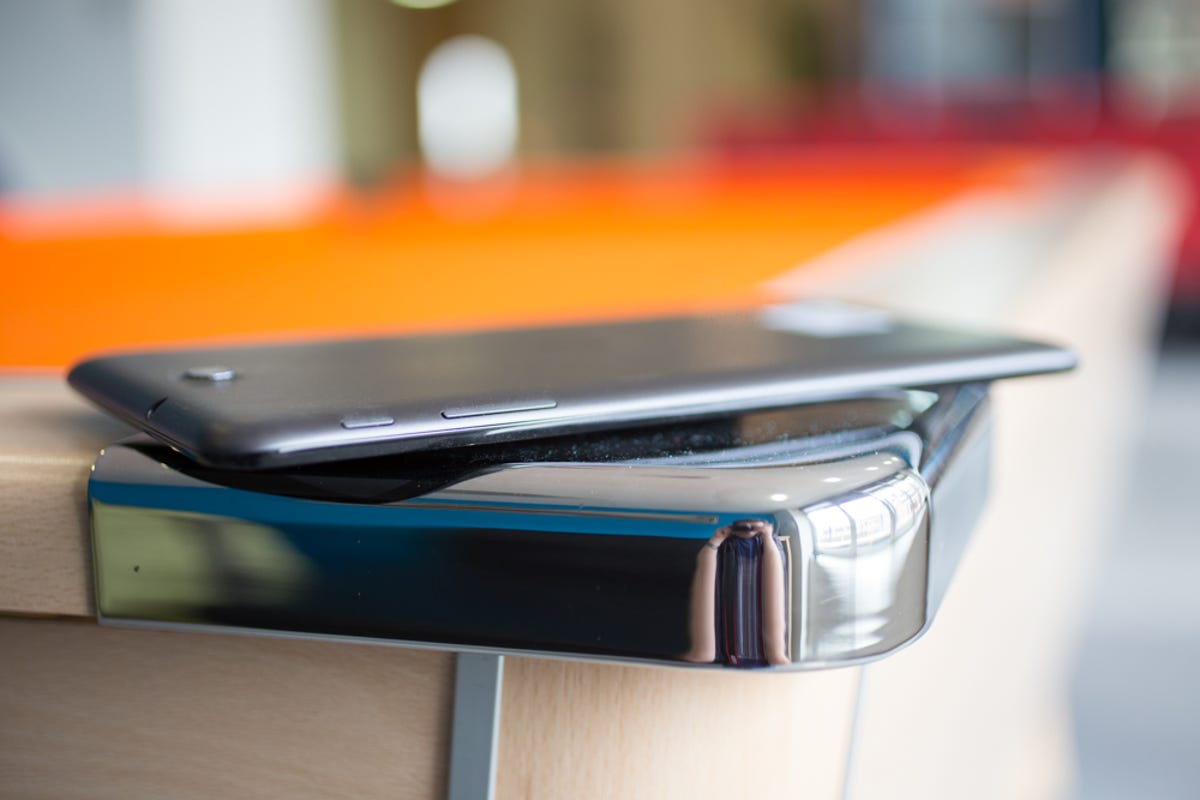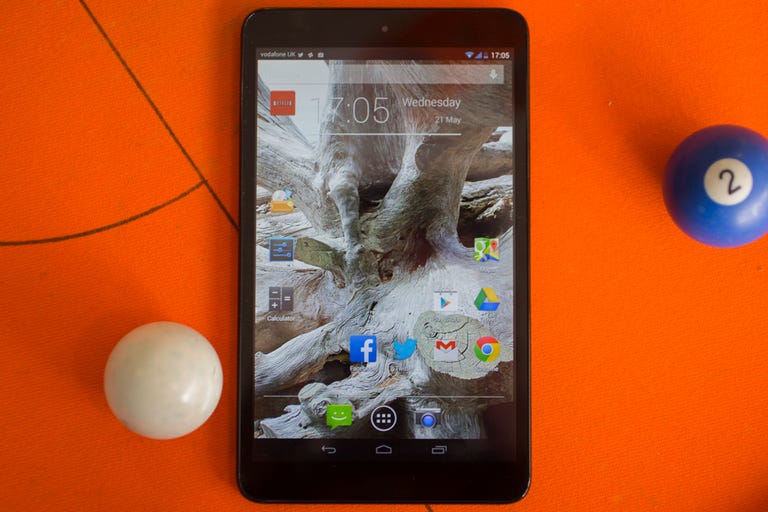 Why You Can Trust CNET
Why You Can Trust CNET Vodafone Smart Tab 4 review: A slim tablet for just £125, but its mediocre screen lacks punch
Vodafone's tablet is cheap, but with rather basic hardware, is it good value? We find out.
Vodafone has settled in to a routine of slapping its label on cheap gadgets for its customers, last year revealing the so-so Smart 3 smartphone . It had an attractive price, but wasn't quite slick enough to earn more than three stars in our review.
The Good
The Bad
The Bottom Line
The red-hued operator's latest effort is the Smart Tab 4, a 3G tablet that can be yours for only £125 on pay as you go, or for £20 per month with a £29 up-front cost on a pay monthly plan. Its major competition is the £199 Nexus 7 and EE's 4G-capable Eagle tablet. So how does it fare?
Design
The Smart Tab 4's style isn't anything new -- a dark grey rectangle with curved edges, but it does sport impressively narrow bezels, so your eye isn't distracted by chunky black bars around the screen, and at 8mm thick it's slim enough to carry around in a handbag or rucksack.

The Smart Tab 4 tips the scales at 328g, which isn't too heavy, but because it's quite long you might find it tipping out of your grip while typing in portrait mode. The back of the tablet is sparsely populated, apart from a 2-megapixel camera, the Vodafone logo, and microSD and SIM-card slots.
Screen
The Smart Tab 4 packs 1,280x800 pixels into its 8-inch frame. That's not an appallingly low resolution, but neither is it spectacular. And in a side-by-side test, the Smart Tab 4 suffers.
Eagle-eyed users will detect an aggravating absence of detail around text and icons, and when playing high-definition video on Netflix this lack of clarity becomes more obvious. The display is quite bright, and a decent viewing angle means the screen is still clear when you tilt the tablet away from you, however.
The screen doesn't compare well with Google's Nexus 7, which has a 1,920x1,200-pixel display, and boasts more natural colours too.
If you're looking for a tablet to just handle email, Web browsing and video chat, the Smart Tab 4's screen resolution is unlikely to bother you too much. If you're into movies and photos, however, that relative pixel paucity will quickly get on your nerves.
Power and software
Deep inside its electric guts, the Smart Tab 4 hides a quad-core processor, clocked at 1.2GHz, and 1GB of RAM. That's a reasonable dollop of computing grunt for the price, and I noticed a little sluggishness while swooping through Android menus.
That said, I did spot that Netflix playback wasn't quite as silky smooth as it was on the Nexus 7, which is powered by a quad-core chip and 2GB of RAM. The graphically demanding Asphalt 8: Airborne racing game was playable on the Tab 4, but didn't feel terribly smooth.
As with the display, if your needs are modest, this is more than enough power in a tablet. But those who enjoy making the most of their gadget's hardware will find the Smart Tab 4 wanting.
Android operating system
The Smart Tab 4 is powered by Google's Android operating system -- the same software that's powering its two closest rivals, the EE Eagle and the Nexus 7.
Android has many advantages. It's flexible, letting you change the layout of your device's homescreen, decorating it with dynamic widgets or gently undulating live wallpapers. You also get access to Google's Play app store, which has loads of apps and games to keep you occupied.
The only downside to Android is that it's not quite as simple to use as Apple's iOS operating system, which is what powers the iPad. Apple is very good at making the process of setting up and using a tablet feel intuitive and easy, while Android takes a bit of getting used to, with more options, tools and menus to contend with.
If you're happy to learn Android's ways, you'll find it's a powerful and rewarding platform, but if you value simplicity above all else, it's a learning curve for first time Android users. Unfortunately, Apple's cheapest tablet currently costs £249, so if you've got less than £200 to spend, Android is currently your only option.
One minor disappointment is that the Smart Tab 4 is powered by Android 4.2.2 Jelly Bean, instead of 4.4 KitKat, which is the latest version. Vodafone does, however, say that an update to KitKat is "planned" -- here's hoping it doesn't take too long to arrive.
Weak camera
The Smart Tab 4's camera is disappointing. With a 2-megapixel resolution we weren't expecting to win any photography prizes, but we were still underwhelmed by the blurry, unclear photos that this snapper produces.
Bizarrely, we also found that the stuttery, sluggish camera app made photos look even worse before they were taken, i.e., the images we framed up using the camera software looked as if they would be extremely blurry, but when we looked at them again in the gallery app, they had acquired some extra detail, and more faithful colour reproduction (though as you can see from our test shots, it's still nothing to write home about).
That's good on the one hand, because it means photos taken with this tablet will generally be slightly better than they seem when you hit the shutter, but for a tablet with a reasonable processor that should be able to power a camera app with more aplomb, it's an unwelcome quirk.
Battery life
In our tests, the Smart Tab 4's battery capabilities proved to be mediocre. With the battery fully charged, we streamed a video (with the tablet's screen set to full brightness), and in three hours and 40 minutes, the Tab 4's battery was down to 33 percent. After five hours and 22 minutes, the Tab 4's reserves were entirely depleted.
With more conservative use you'll likely get the Tab 4 to last you until night-time without much concern, but expect to have to charge it every few days.
Do you need 3G?
The Nexus 7 may be more slick, but the version with a SIM-card slot for mobile data is very expensive (on Google's Play store it's only available as the 32GB model, and costs £299 in total). The Tab 4 meanwhile has space for a Vodafone SIM, so you can browse the Web and download apps while out and about.
That certainly makes the Tab 4 sound like it has a real advantage, but there are some caveats. Firstly, the Tab 4 doesn't support faster 4G mobile data, so you'll be limited to 3G speeds while browsing and downloading. 3G is fast enough to send an email or load a Web page without too much delay, but downloading apps or streaming video won't feel as rapid.
Another option you could consider -- if 4G speed is important to you -- is EE's recently announced Eagle tablet, though this costs £200 and isn't really any more impressive than the Tab 4 in the specs department. Paying for 4G on an ongoing basis can also be a pricey business.
Wi-Fi only tablets aren't necessarily stranded when they're away from a Wi-Fi connection, however. An option to look into is tethering your tablet to your smartphone, to funnel your phone's data connection to your larger-screened device. If you have a smartphone and a plan that allows tethering (and a decent amount of data on your plan), you can use your phone as a mobile hotspot, and can get your tablet online this way, as and when you need a connection.
Conclusion
The Vodafone Smart Tab 4 has an attractively low up-front price tag, but offers little to get excited about. With its 3G powers, this would be a workmanlike device if you're purchasing a tablet solely for simple tasks like Web browsing and checking email on the move. If, however, you don't occupy this narrow niche and want a tablet for enjoying photos, videos or gaming, it's worth saving the extra £75 and opting for Google's Wi-Fi only Nexus 7, which is a more powerful and better-looking Android tablet.


